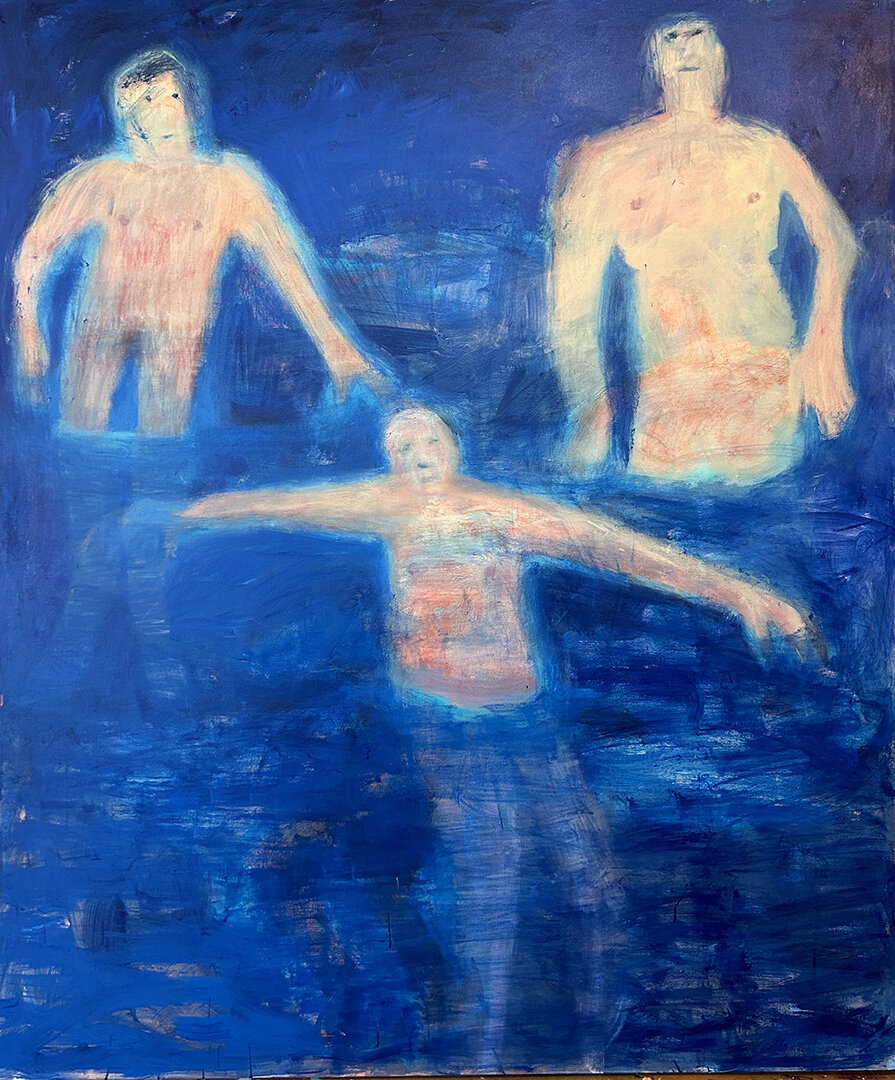Hall 3 [16-18]

Katherine Bradford, Swimmers in Blue, Horizontal, 2023
Acrylic on canvas, 172,7 x 203,2 cm
Courtesy Katherine Bradford, New York

Katherine Bradford, Trio of Swimmers on Blue, 2023
Acrylic on canvas, 203,2 x 172,7 cm
Courtesy Katherine Bradford, New York
In her entire practice, Katherine Bradford’s strong connection to water becomes particularly apparent. She has repeatedly made use of this element, not only to reference fluidity and unity in identity, but also as a compositional device. People are also primarily made of water, as the artist once emphasized in an interview.
Sometimes a figure is only visible from the torso upwards; elsewhere the bodies become empty silhouettes. But even while the figures in Bradford’s water paintings are fragmented into limbs and parts by the water, foreground and background, human(s) and water merge as one in the interlocking planes of pigment paint and together form an all-encompassing and holistic structure. Through the skillfully selected color relationships of these components, Bradford’s implicit narratives of fluidity are reinforced. According to the artist, her preference for the water theme is based on her view that water corresponds to her use of color, not only as a medium, but as a dense substance with its own essence, capable of creating colorful fields of forms and bodies.
Painting offers a unique method to express this holistic approach to bodies, landscapes and water. No other medium is able to emphasise on this perspective, which is an important concept for many environmental activists. Without coming across as vitalist, the works shown in this room are ultimately about the shared experience of water.
The composition of Swimmers in Blue, Horizontal (2023) [16] is reminiscent of Henri Matisse’s The Dance (1909) seeking to capture a more universal experience. Comparable to the intensity of colors of Matisse’s water lilies, these figures blur in the water as a luminous whole.
Trio of Swimmers on Blue (2023) [17] recalls the standing figures in Afternoon of Spring (1954) by Jan Müller, a painter from Hamburg who emigrated to the USA, and whose protagonists, although merging to a lesser extent with the background, are also depicted as indistinguishable identities both in terms of class and gender.
Another narrative level in Bradford’s paintings of swimmers also refers to social inequality. In certain activities, such as swimming, young and old, rich and poor, slim and non-slim, all meet in the water. This is reminiscent of the Dutch panorama paintings by Hendrick Avercamp, such as A Scene on the Ice (ca. 1625), in which everyone in the 17th century met on the ice despite their different costumes, and each dealt with the temptations and demands of nature and its different aggregate states in the best possible way according to their mood. Likewise, Bradford equalizes her subjects by bringing them into the water, in swimwear or without clothing, such that they transcend their respective social status and come together, at least for a moment.
[16]
Swimmers in Blue, Horizontal, 2023
Acrylic on canvas
172,7 x 203,2 cm
Courtesy Katherine Bradford, New York
[17]
Trio of Swimmers on Blue, 2023
Acrylic on canvas
203,2 x 172,7 cm
Courtesy Katherine Bradford, New York
[18]
Figure Walking Out to Sea, 2024
Acrylic on canvas
203,2 x 172,7 cm
Courtesy Katherine Bradford, New York